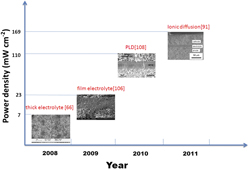Crossref Citations
This article has been cited by the following publications. This list is generated based on data provided by
Crossref.
Lyagaeva, Yu. G.
Medvedev, D. A.
Demin, A. K.
Yaroslavtseva, T. V.
Plaksin, S. V.
and
Porotnikova, N. M.
2014.
Specific features of preparation of dense ceramic based on barium zirconate.
Semiconductors,
Vol. 48,
Issue. 10,
p.
1353.
Liu, Zhan-Guo
Ouyang, Jia-Hu
Sun, Ke-Ning
and
Zhou, Yu
2014.
Effect of metal oxides on the densification and electrical conductivity of the GdSmZr 2 O 7 ceramic.
Journal of Alloys and Compounds,
Vol. 617,
Issue. ,
p.
393.
Rabuffetti, Federico A.
and
Brutchey, Richard L.
2014.
Complex perovskite oxide nanocrystals: low-temperature synthesis and crystal structure.
Dalton Trans.,
Vol. 43,
Issue. 39,
p.
14499.
Wang, Li
Habibi, M.H.
Eldridge, Jeffrey I.
and
Guo, S.M.
2014.
Infrared radiative properties of plasma-sprayed BaZrO3 coatings.
Journal of the European Ceramic Society,
Vol. 34,
Issue. 15,
p.
3941.
Lyagaeva, J.
Medvedev, D.
Filonova, E.
Demin, A.
and
Tsiakaras, P.
2015.
Textured BaCe0.5Zr0.3Ln0.2O3− (Ln = Yb, Y, Gd, Sm, Nd and La) ceramics obtained by the aid of solid-state reactive sintering method.
Scripta Materialia,
Vol. 109,
Issue. ,
p.
34.
Bi, Lei
Boulfrad, Samir
and
Traversa, Enrico
2015.
Reversible solid oxide fuel cells (R-SOFCs) with chemically stable proton-conducting oxides.
Solid State Ionics,
Vol. 275,
Issue. ,
p.
101.
Medvedev, D. A.
Murashkina, A. A.
and
Demin, A. K.
2015.
Formation of dense electrolytes based on BaCeO3 and BaZrO3 for application in solid oxide fuel cells: The role of solid-state reactive sintering.
Review Journal of Chemistry,
Vol. 5,
Issue. 3,
p.
193.
Yun, Dae Sik
Joo, Jong Hoon
Yu, Ji Haeng
Yoon, Hyung Chul
Kim, Jong-Nam
and
Yoo, Chung-Yul
2015.
Electrochemical ammonia synthesis from steam and nitrogen using proton conducting yttrium doped barium zirconate electrolyte with silver, platinum, and lanthanum strontium cobalt ferrite electrocatalyst.
Journal of Power Sources,
Vol. 284,
Issue. ,
p.
245.
Wang, Yanzhong
Huang, Jin
Su, Tingting
Liu, Wei
Qi, Huijun
and
Yang, Jinlong
2015.
Synthesis, microstructure and electrical properties of BaZr0.9Y0.1O3−δ:BaCe0.86Y0.1Zn0.04O3−δ proton conductors.
Materials Science and Engineering: B,
Vol. 196,
Issue. ,
p.
35.
Mitri, Stratigoula
Medvedev, Dmitry
Kontou, Sotiria
Gorbova, Elena
Demin, Anatoly
and
Tsiakaras, Panagiotis
2015.
Polarization study of Fe|BaCe0.5Zr0.3Y0.08Yb0.08Cu0.04O3-δ|Fe electrochemical cells in wet H2 atmosphere.
International Journal of Hydrogen Energy,
Vol. 40,
Issue. 42,
p.
14609.
Bi, Lei
Shafi, Shahid P.
and
Traversa, Enrico
2015.
Y-doped BaZrO3as a chemically stable electrolyte for proton-conducting solid oxide electrolysis cells (SOECs).
Journal of Materials Chemistry A,
Vol. 3,
Issue. 11,
p.
5815.
Tao, Zetian
Yan, Litao
Qiao, Jinli
Wang, Baolin
Zhang, Lei
and
Zhang, Jiujun
2015.
A review of advanced proton-conducting materials for hydrogen separation.
Progress in Materials Science,
Vol. 74,
Issue. ,
p.
1.
Bi, Lei
and
Traversa, Enrico
2015.
ChemInform Abstract: Synthesis Strategies for Improving the Performance of Doped‐BaZrO3 Materials in Solid Oxide Fuel Cell Applications.
ChemInform,
Vol. 46,
Issue. 26,
Hou, Jie
Qian, Jing
Bi, Lei
Gong, Zheng
Peng, Ranran
and
Liu, Wei
2015.
The effect of oxygen transfer mechanism on the cathode performance based on proton-conducting solid oxide fuel cells.
Journal of Materials Chemistry A,
Vol. 3,
Issue. 5,
p.
2207.
Fu, Shancan
Mei, Yunhui
Li, Xin
Ning, Puqi
and
Lu, Guo-Quan
2015.
Parametric Study on Pressureless Sintering of Nanosilver Paste to Bond Large-Area (≥100 mm2) Power Chips at Low Temperatures for Electronic Packaging.
Journal of Electronic Materials,
Vol. 44,
Issue. 10,
p.
3973.
Lyagaeva, Yu. G.
Vdovin, G. K.
Nikolaenko, I. V.
Medvedev, D. A.
and
Demin, A. K.
2016.
The modification of BaCe0.5Zr0.3Y0.2O3–δ with copper oxide: Effect on the structural and transport properties.
Semiconductors,
Vol. 50,
Issue. 6,
p.
839.
Shao, Zongping
and
Tadé, Moses O.
2016.
Intermediate-Temperature Solid Oxide Fuel Cells.
p.
1.
Danilov, N.
Vdovin, G.
Reznitskikh, O.
Medvedev, D.
Demin, A.
and
Tsiakaras, P.
2016.
Physicо-chemical characterization and transport features of proton-conducting Sr-doped LaYO3 electrolyte ceramics.
Journal of the European Ceramic Society,
Vol. 36,
Issue. 11,
p.
2795.
Bu, Junfu
Jönsson, Pär Göran
and
Zhao, Zhe
2016.
The effect of NiO on the conductivity of BaZr0.5Ce0.3Y0.2O3−δ based electrolytes.
RSC Advances,
Vol. 6,
Issue. 67,
p.
62368.
Drąg‐Jarząbek, Anna
John, Łukasz
Petrus, Rafał
Kosińska‐Klähn, Magdalena
and
Sobota, Piotr
2016.
Alkaline Earth Metal Zirconate Perovskites MZrO3 (M=Ba2+, Sr2+, Ca2+) Derived from Molecular Precursors and Doped with Eu3+ Ions.
Chemistry – A European Journal,
Vol. 22,
Issue. 14,
p.
4780.
